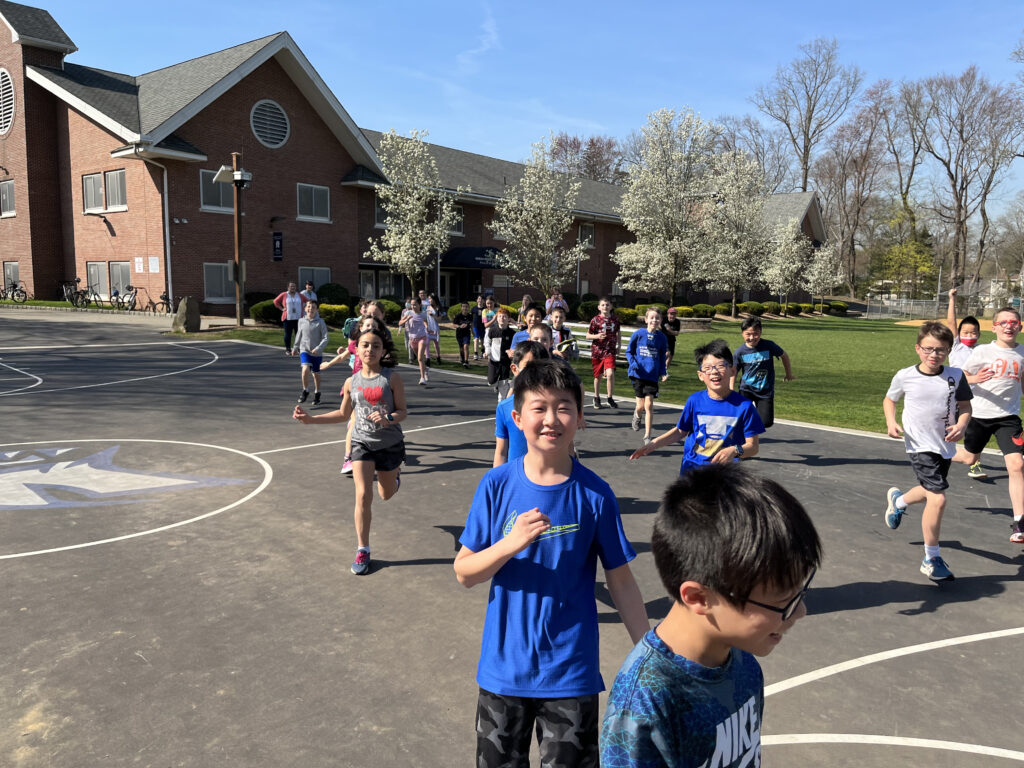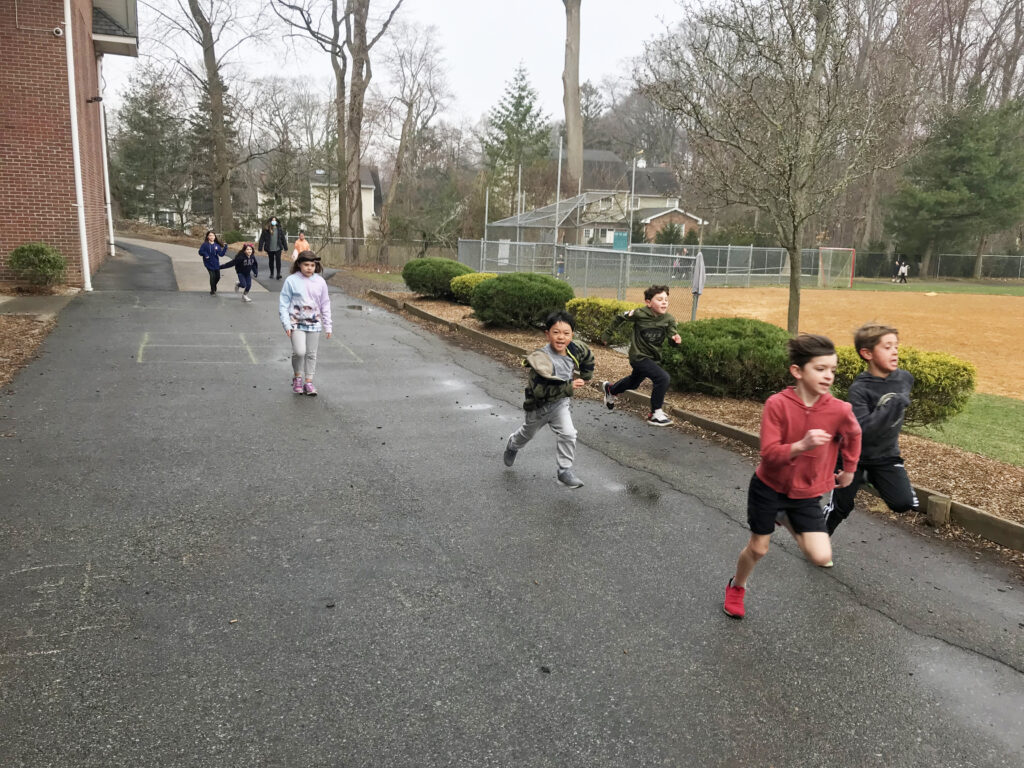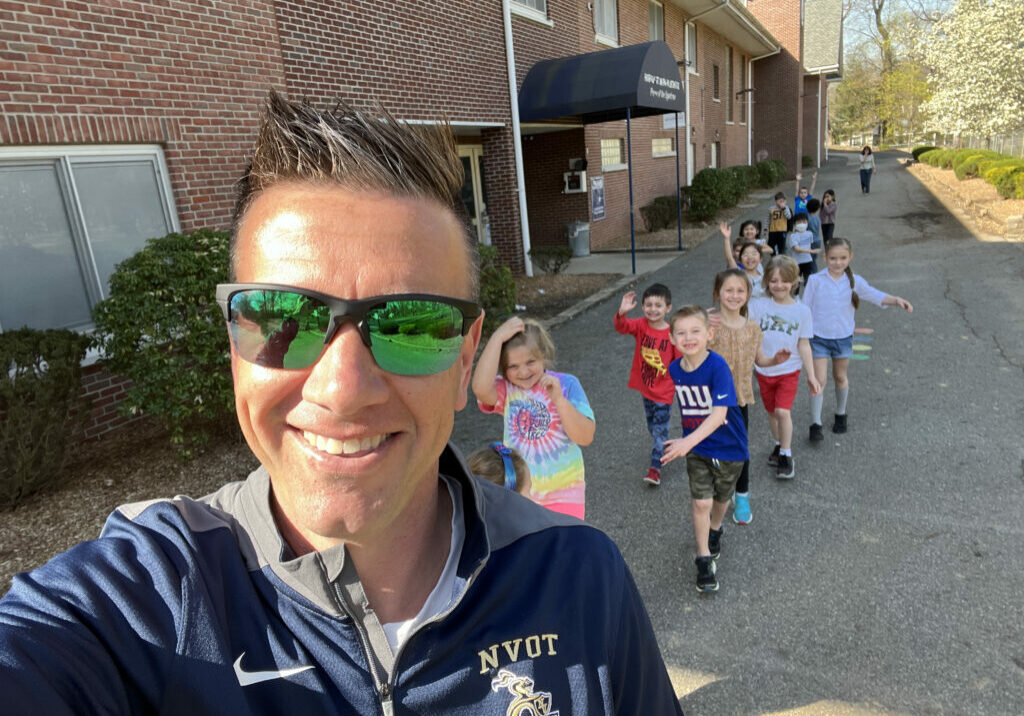Movement-based education with a focus on SEL opportunities
By Mark S. Torrie
In the small district of Harrington Park, in Bergen county, a movement is afoot. This movement, a free initiative that came to our shores via the U.K., combines movement-based education with opportunities to improve student and staff social and emotional learning. Best yet, it is accessible to all and can be done in as little as 15 minutes, three times per week.
In fact, turn up to Harrington Park School in the morning—or really any part of the day—and you will be amazed at the flushed little faces racing around the back field, alongside their teachers, enjoying the sunshine. The buzz is palpable. Whether students run the whole time is completely up to them. As individuals, groups or with staff, they choose the level of intensity in a manner that not only works on physical fitness but boosts their brain performance and gives extra opportunities for social interaction during the school day.

A movement-based movement
So what is this movement? The Daily Mile is the brainchild of former Scottish Head Teacher Elaine Wyllie MBE (Member of the Order of the British Empire). Ten years ago, as the head teacher of St. Ninian’s Primary School in Stirling, Scotland, Wyllie became acutely aware of the students’ lack of fitness and decided to act. She understood the relationship between physical well-being and overall student outcomes, so she created an easy to implement initiative that changed the culture of the school.
Sometimes the best idea is the simplest, and Wyllie proved it. She instituted a 15-minute-a-day program that encouraged students to run, jog or walk around the school’s field to improve their overall fitness. Staff were likewise encouraged to join in to show a good example for the students. The students went out in warm weather (it’s rarely hot in Scotland), cool weather, cold weather, and even inclement weather. Within six months, Wyllie recognized the impact these 15 minutes were having on not only the students’ physical fitness, but their classroom behaviors too.
The program quickly spread throughout my native Scotland and south into the other countries making up the United Kingdom. From there it has traveled worldwide and is currently being utilized in over 86 countries. Over 3 million children worldwide are signed up to take part and it is easy to see why.
In addition to the extra exercise, students set goals, track their progress and are provided with SEL opportunities along the way to develop key personality traits. The Daily Mile website (thedailymile.us) is stocked with resources that teachers and guidance counselors can use to round out their positive experiences.

The Daily Mile boosts positive social interaction, brain performance and physical fitness.
Collaboration: a root cause and effect in Harrington Park
During the 2020-21 school year, with limited gym equipment available due to COVID protocols, our physical education team came up with the idea to institute a walking initiative in which our students would attempt to walk the distance from Harrington Park, New Jersey, to my hometown of Forfar, Scotland.
In addition to the daily walking, students tracked their journey via the website created for the program. Students learned history, geography and culture for the states of New England, the Canadian provinces and countries en route across the great Atlantic Ocean. The culminating event took place when the students walked into “Forfar” and were met by a bagpiper in the front of the school, followed by a personal video message from children in Scotland.
The success was evident, and the interdisciplinary nature of the initiative led to a question: How can we expand this across the school? Born out of a conversation in the spring between Harrington Park’s Physical Education and Guidance departments, we decided to mobilize the SDGP (self-directed growth plan) process and see if other teachers would be willing to give it a go with their students. Fortunately for us, the ever-supportive Harrington Park administrators jumped all over it and so it began in September 2021.
I, for one, was still unsure as to how receptive the teachers were going to be. I had a suspicion that the focus on the new school year would be on trying as hard as possible to catch up from the past 18 months.
We all know that teachers have so much on their plates that to add yet another obligation was a concern of ours, but those fears were misplaced. I presented the initiative on the first day of school and it was met with an overwhelmingly positive response from my colleagues. Not every class signed up, but many did, and so for the 2021-22 school year, around 50% of our students reaped the rewards.
What are the data saying?
As part of the SDGP process, it’s imperative that data are collected along the way to measure the various levels of success witnessed throughout the school year in order to drive future tweaks and improvements to the initiative. Fortunately, the Daily Mile affords opportunities to measure aspects of student and staff physical, cognitive, social and emotional well-being.
For the physical component, the health office provided body mass index (BMI) data from the student physicals that were recorded at the start of the school year. This is completely anonymous as to not break any HIPAA laws and was reassessed in late spring for a comparative analysis—no one other than our school nurse knows which students match which BMI. This may prove futile in providing any sort of meaningful data, but BMI was chosen over weight, because as the students grow, they inevitably will become heavier.
Interestingly enough, BMI steadily increased in almost every class that was tested. This was interesting as in order to ascertain the impact of the Daily Mile on student physical well-being we probably needed to measure body fat percentage but don’t currently have the capability for that. So we substituted it for BMI, which increases through weight gain but doesn’t really account for weight gain due to muscular growth and other changes.
The second aspect for physical assessment is on cardiovascular endurance. Students at the start, middle and end of the year recorded the number of laps that they completed in the 15-minute timeframe. Cardiovascular fitness improved in every class that was tested from the start of the school year through the end of the year. In fourth grade there was a slight dip in the middle of the year. This could be explained by the harsh winter and lack of Daily Mile time during this period. However, overall, the benefits for the students’ cardiovascular systems are consistent and positive.
The remaining components of cognitive and social and emotional learning have been tracked and tested in a variety of ways. The SEL component includes mood meters, self-reflection journals, goal setting, goal tracking, and a multitude of other activities that are provided by the Daily Mile. The main tool for cognitive learning was the use of a Daily Mile video that was turned into an Edpuzzle assignment that reiterates for students that their success in life is intimately connected to their personal health and wellness.

Next steps (pardon the pun)
The Harrington Park staff will continue to monitor the benefits the Daily Mile has on our students. In addition, the guidance department will push into classrooms to focus on some of the SEL activities aimed at developing key character traits within the students. The key here though is to keep getting the kids outdoors—rain or shine—and keep the kids moving. The scientific literature shows that an uptick in movement, vitamin D absorption and the release of endorphins in the brain, all lead to happier and healthier people.
The last aspect of the SDGP process was to finalize the data from all the components and then begin to analyze areas of strength and positive growth, as well as areas that could be improved moving forward. This was presented to the administration, superintendent and board of education in early June prior to the end of the school year. All staff members involved were present and spoke to the benefits observed over the course of the past school year.
With the overall success we saw last year, it is fair to say that Harrington Park will be continuing with and expanding the initiative into the 2022-23 school year. The details are to be finalized, but discussions have taken place to secure a 15-minute block for the middle school students to get out and burn off some steam while the PreK- 4 grades will remain as is and enhanced when the students need it.
Mark S. Torrie is as physical and health education teacher at Harrington Park School in Bergen County. He can be reached at torrie@hpsd.org.
What are the stakeholders saying?
Students
58% of our fourth-grade students expressed that they felt happy after completing their daily mile run. 81.1% said they feel more focused and able to pay more attention to their classwork. In addition to these statistics, 91.3% of students in fourth grade think that the Daily Mile is a positive initiative and one that should remain in place moving forward.
Staff
Quotes from staff members involved in the initiative would appear to corroborate with the student findings. When asked if teachers thought the Daily Mile was contributing to their own health and mental wellness, responses included:
- “Yes – It feels good to get outside, enjoy some fresh air, take off the mask for a bit, and see the students’ faces again.”
- “Exercise is important to your well-being! Getting a mile in is rewarding for me, and it clears my mind and gives me a fresh start to the next part of my day.”
- “Yes. The fresh air is great for my own reflection on my practice, and I’m bonding with my students in a way I wouldn’t usually be able to.”
Administration
Vice Principal Ross Herbert states, “The students and teachers enjoy the Daily Mile as it gives them some time to pause from the fast-paced nature of the school day to stretch their legs, enjoy the weather and enjoy time with each other. Both the students and staff have commented that the Daily Mile not only is reinvigorating, but it also refocuses them.”
Principal Jessica Nitzberg believes that “the Daily Mile has been a strong unifying and collaborative initiative. No matter the grade level or subject area, each day students and staff have the opportunity to get outside in the fresh air to exercise, connect with one another and reset.”
Parents
Possibly the most excited group that we have spoken to is the parents and their perception of the new initiative is again overwhelmingly positive. One parent that I had a recent conversation with said, “I think the Daily Mile allows educators to afford students the opportunity to educate and motivate themselves to be more conscious of their well-being and to fight against inactivity that has plagued many of our younger children. Moreover, it allows educators to move beyond the traditional classroom setting to keep kids active.”
